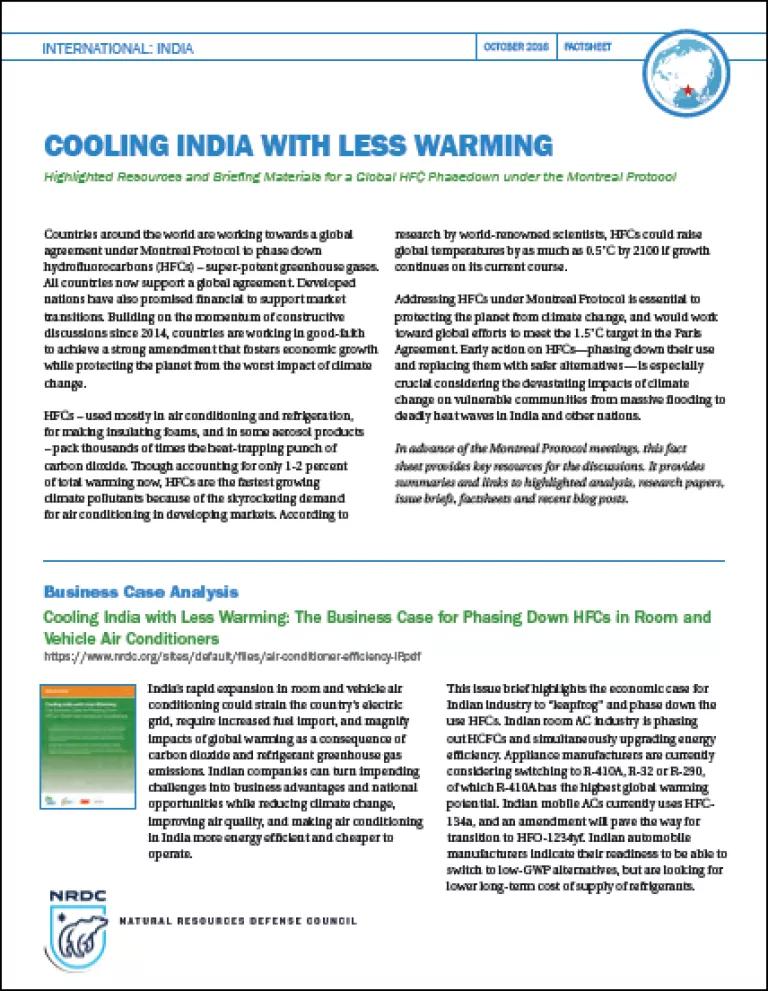
India is a buzz with their ratification of the Paris Climate Agreement and subsequent ratification by the EU and entry into force. At the World Sustainable Development Summit in New Delhi, delegates from around the world are celebrating the landmark achievement. Building on the momentum from the Paris Agreement, the first session of the summit kicked off with a major discussion on “transitioning to more energy efficient air conditioners in moving toward climate-friendly refrigerants”. The discussion is timely since nations gather in Rwanda this week to hammer out a deal to amend the Montreal Protocol to phase down hydrofluorocarbons (HFCs)—super potent greenhouse gases.
HFCs—used mostly in air conditioning and refrigeration, for making insulating foams, and in some aerosol and other products—have more than 10,000 times the global warming potential as carbon dioxide. Though accounting now for only 1-2 percent of total warming now, HFCs are the fastest growing climate pollutants because of the skyrocketing demand for air conditioning and refrigeration in developing markets—such as India. Addressing HFCs under Montreal Protocol is essential to protecting the planet from climate change, and would work toward global efforts to meet the 1.5˚C pathway outlined in the Paris Agreement.
During the summit, government officials and experts focused on early action on phasing down highly warming HFCs, including advancing energy efficiency and replacing HFCs with safer and more energy efficient alternatives. India needs more energy efficient and climate friendly air conditioners to meet its demand for cooling and energy. Energy smart cooling is also needed considered the devastating impacts of climate change on vulnerable communities from massive flooding due to deadly heat waves in India and other nations.
Special Secretary R.R. Rashmi from India’s Ministry of Environment, Forests and Climate Change gave the key note address and emphasized the importance of consensus.
“There is no doubt that we need to move towards low global warming potential refrigerants. The global initiative on energy efficiency is a welcome move.”
The discussion focused on the need for technologies, financing, and best practices and options available for India as a main focus for Kigali. The group also discussed the opportunities for more efficient air conditioning with companies, such as Daikin and Godrej, moving to more efficiency and climate friendly products.
Dr. Ajay Mathur, Director-General of The Energy and Resources Institute (TERI) announced a new initiative focused on driving efficiency and climate friendly air conditioners partnering with Dr. Stephen Andersen from the Institute of Governance and Sustainable Development (IGSD) and other partners. The initiative would align public and private energy efficiency programs to make super-efficient room ACs using lower global warming potential (GWP) refrigerants profitable. Part of the ambition is to design and implement programs for the Indian market that would leverage the $80 million in new funding focused on developing markets for “fast-start support for implementation and energy efficiency improvements”. Experts also discussed R&D opportunities for energy smart air conditioners in India. Another key issue that was discussed is that an effective HFC phase down that needs a robust replenishment of the Montreal Protocol’s Multilateral Fund.
In efforts to work towards consensus, the Indian government is engaging in a series of discussions including the international session at the summit. The selection of baseline and freeze years for phasing down HFCs for developing countries was discussed. Current options on the table diverge by over 10 years. The difference between the least and most ambitious proposal is nearly 50 gigatonnes of CO2 emissions—equivalent to emissions from the entire global economy for five full years. India is proposing 2031; China and Pakistan propose 2025; and the majority of developing and developed countries, including the African group, Pacific Island countries, Latin America countries, North America and the European Union, are proposing 2021. Central to the start date (freeze year) discussions are industry views and the cost of an HFC phasedown and environmental benefits.

Looking ahead to Rwanda, NRDC released a new fact sheet that highlights key resources for the discussion. Achieving an amendment in Rwanda will take hard work and compromise. The Paris agreement showed us that nations can come together to address one of the greatest threats facing our planet. As former Executive Secretary, United Nations Environment Program (UNEP), Marco Gonzalez summarized with an optimistic note, “the international community is expecting an agreement at Kigali.”



